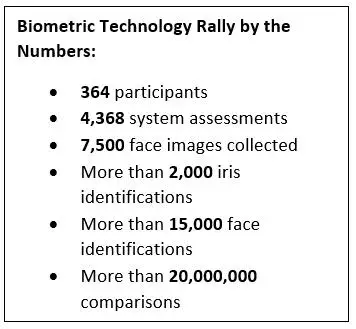Balancing speed and security at checkpoints, like airports, is essential to ensuring safe, reliable travel. Many of these checkpoints are increasingly using biometric technology to improve speed and reliability. While recent improvements in biometrics have lowered failure to match rates, many systems fail to quickly acquire biometric information in the first place.
The Department of Homeland Security Science and Technology Directorate’s (S&T) first Biometric Technology Rally, held in March at S&T’s Maryland Test Facility (MdTF), aimed to eliminate these obstacles by testing face and face/iris recognition systems. The MdTF designed a standard security checkpoint process to test the ability of biometric identity systems to acquire and match images from a diverse volunteer population within a realistic time constraint.
Watch the Biometric Technology Rally Video
The Biometric Technology Rally builds off of recent S&T partnerships with the Transportation Security Administration (TSA) and Customs and Border Protection (CBP) to improve the speed and reliability of biometric systems.
“At Customs and Border Protection, our biggest challenge over the past several years has been collecting biometrics for people departing the United States where, unlike the arrivals process, we operate without a dedicated, secure environment,” said CBP Deputy Executive Assistant Commissioner John Wagner. “We are looking to work with partners and stakeholders to develop a process that doesn't shut down travel, but enhances security and efficiency.”
Innovative systems from 11 industry participants representing 10 countries from around the world were selected to participate in the rally. S&T challenged industry to meet specific objective performance goals along three interlinked categories of evaluation metrics: effectiveness, efficiency, and satisfaction.
Effectiveness measured performance of the biometric system, including failures to acquire, process, and match images. S&T challenged industry systems to identify 99 percent of all volunteers using the system in under 20 seconds.
Efficiency measured the average time volunteers spent using each system. S&T challenged industry to design intuitive systems that volunteers could understand and use in just five seconds.
In addition to these technical metrics, S&T wanted to develop systems that are enjoyable to use as measured by satisfaction feedback. Volunteers used a kiosk to rate their happiness after using each system. Industry was challenged to provide systems with at least a 95 percent user satisfaction rate.
Over the course of the 10-day event, 364 volunteer test subjects representing a diverse range of ages and demographics performed a total of 4,368 individual system assessments.
“We are very pleased by the outcome of this rally,” said Arun Vemury, DHS S&T Program Manager and Biometric Technology Lead. “Not only will the results be beneficial for understanding to capabilities of cutting edge systems and driving future research and development, but industry participants gained a better understanding of the strengths and possible areas for improvement of their biometric systems, having now used them in a systematic, rigorous, and realistic, high-throughput environment.”
very pleased by the outcome of this rally,” said Arun Vemury, DHS S&T Program Manager and Biometric Technology Lead. “Not only will the results be beneficial for understanding to capabilities of cutting edge systems and driving future research and development, but industry participants gained a better understanding of the strengths and possible areas for improvement of their biometric systems, having now used them in a systematic, rigorous, and realistic, high-throughput environment.”
In addition to data collection, S&T held a Stakeholder Demonstration Day in which 100 representatives from more than 20 government components and private organizations visited the MdTF to learn more about the industry participants and their systems. Organizations represented included DHS components, the Department of Defense, the Department of State, the National Institute of Standards and Technology, the General Services Administration, the United Kingdom, and various airports and airlines.
Melissa Conley, Senior Advisor for the Transportation Security Administration’s Office of Requirements and Capabilities Analysis, agreed.
“Over the 13 years that I’ve been at TSA, this is one of the first technology rallies that has offered such a diverse suite of capabilities for us to look at in a short period of time,” said Conley. “It was very informative.”
Results from the rally will be used to inform DHS procurement activities such as operational tests, pilots, and system acquisitions. This event will be the first in a series of S&T Biometric Technology Rallies focusing on different biometric modalities and areas of interest.
“The results of this rally will help inform the focus of future MdTF testing events, and the team will walk away with a number of ideas about how to make the next rally even more effective,” said Vemury.
“Today, TSA got to see a bunch of different solutions, a bunch of different use cases, and that’s really important market research for us as we move forward in implementing biometric technology,” Conley said. “S&T is doing all of the leg work for us to make sure these algorithms and these technologies and these companies meet certain thresholds so we can streamline our procurement process.”
Visit the MdTF web page to sign up to receive information about future rally events.
